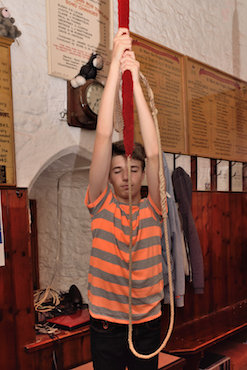A balanced ringing style
Which hand is doing most of the work?
Many learners don’t achieve a handstroke pull where the work is equally shared between the hands. For the purposes of simplicity, I am going to assume the learner has the tail end in the left hand. What you often see, to a greater or lesser degree, is the right hand in charge of the sally, taking hold of it before the left, doing most of the pull and letting go later than the left. Let’s look at the origin of the problem and then some ways to resolve it.
One of the trickier parts of learning to handle a bell is getting the left hand to deal with both the tail end and the sally. The learner fears they will drop the tail end and so we get all manner of potential handling issues as they try to reduce this perceived risk. One of these involves letting the right hand manage the sally, allowing the left time to deal with the tail end and then join it. The left hand then leaves the sally early, leaving the right to do the actual work.
Resolving the problem is something that’s ideally done during the process of learning to handle. However, we don’t live in that ideal world. We live in the real world with all its flaws. Please don’t come to my tower expecting to see nothing but perfect styles and hear nothing but perfect striking! I do my best, as do my ringers, but all are human with human imperfections and challenges.
So, what’s my take on this?
First, I will discuss with the learner (at whatever stage) why it is desirable that both hands/arms share the work. I make a bit of a joke about developing muscle only on one side, but we seriously consider the ringing action and that it is far better for the body to work as evenly as possible. In addition, the bell control at all stages (raising, ringing, lowering) will be more efficient. Depending on the individual, we may use a short video clip of their ringing to allow them to compare this to other people’s styles. It’s a fact that what someone feels they are doing may not be what they’re actually doing and video proof is what can convince them of this. I also find that before/after videos are really helpful. Sometimes they may like to keep copies for future reference – after all, whenever a ringer has a “weak point” in their handling it often crops up time and time again when they’re under stress, learning new things.
The next stage is a physical exercise. I ask them, with support, to ring the bell with just the left hand, keeping the other behind their back. Most require a good bit of support to have the confidence to even try this; I assure them my hand will be there as insurance. However, I am careful to add nothing at all to the pull. What normally happens is they struggle to pull off a bell they normal ring and are quite shocked. After a couple of slight fumbles with the sally due to them worrying about it, they quite quickly realise that they can ring the bell one handed as long as someone is there to make sure all is well.
I then ask them to ring the bell with the only the right hand working the sally. Again, I will put my hand on it to protect the stay if necessary. This time they usually find they can pull off with ease.
Essentially what we are doing is allowing the learner to discover for themselves how evenly they’re working. From this point the instruction is to focus intently on the left hand and be aware of its input. Then allow the right hand to stop pulling and just be there passively before gradually achieving a balance between the hands. The learner is encouraged to ring a few whole pulls on their own whenever possible, perhaps just a few prior to rounds starting or ringing the service bell on a Sunday as this offers private practice time. Then they’re asked, whenever ringing something that is straightforward for them, to repeat this exercise of focusing on the balance of work. Don’t expect a quick permanent fix – it will take time and desire from the learner to correct the habit.
Remember, practice doesn’t make perfect, it makes permanent!

Heather Peachey
